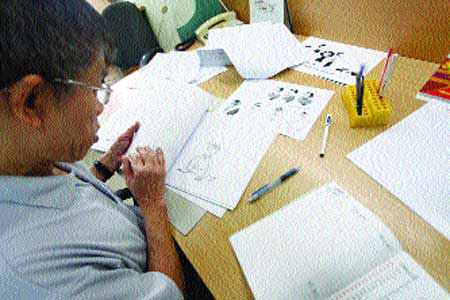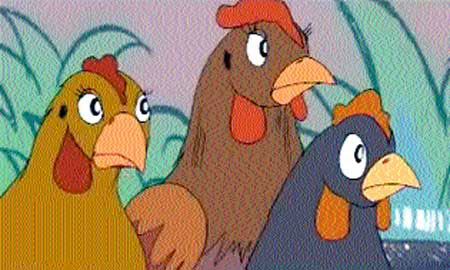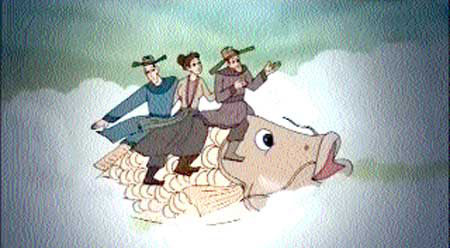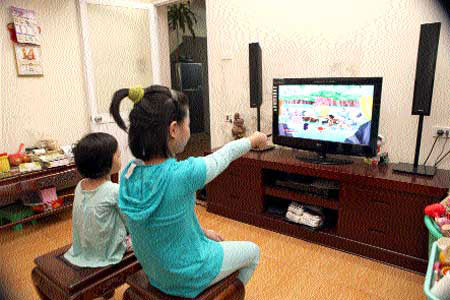|
The American tradition of Saturday Morning
Cartoons may be over, but in Ha Noi TVs are keeping pace with kids' appetite
for American cartoon classics for better or for worse. Lucy Sexton reports.
Across the United States in the 1960s, families could
be seen parking their Ford cars as close to the front door as possible,
opening up their trunks and shuffling in clunky TV sets heavy enough to break
a back or two.
In the year 1960, American screens aired the first
episode of the famous Flintstones cartoon and the first presidential debate
ever broadcast, guiding in a handsome John F. Kennedy to the presidency and
forever changing the landscape of American politics. Politics, family
sitcoms, commercials and Saturday Morning Cartoons had officially invaded
living rooms across the country – and they never left.
Well, except the time-honoured tradition of Saturday
Morning Cartoons, which claimed 20 million viewers in its heyday. This
October 4 was the first Saturday in
Gone is the ritual of waking up just in time to fill a
bowl with a colourful, sugary excuse for a cereal before settling down in
front of the TV for a 9am showing of classics like Tom and Jerry, Bugs Bunny,
Batman, Dragon Ball Z and Yu-Gi-Oh!.
But, here in Ha Noi, the tradition perhaps lives on,
just with a few slight alterations. Instead of a sugary bowl of cereal, kids
might slurp up a bowl of pho ga. Rather than wait till 9am, cartoons start as
early as 6am on Saturdays. Instead of mindlessly watching a cartoon in their
native language, kids are performing their mysterious ability to absorb
meaning from kinetic chaos and soak in new languages like sponges.
Phuong Hong, 25, says TV cartoons are part of daily
life for all the kids in her family, from infants to 14-year-olds.
"Kids watch cartoons all the time, when they stay
at home or while off studying, whenever they have free time."
She recounts wars fought over the TV. "In the
morning, parents often turn on the TV for updates on current affairs but the
children turn it to their channel."
According to several parents spoken to on the subject,
they all try their best to reduce the hours kids spend in front of the screen
– one parent doesn't even have a TV in the house so as to avoid the issue
altogether.
One mother says her kid is allowed one to two hours of
cartoons every Saturday morning but that she has had to fight off his
TV-beleaguered tantrums. Other parents mention that their kids get one to two
hours in the evening during dinner or after they finish their homework and
then on Saturday and Sunday mornings, of course.
Like most who recognise the wild popularity of cartoons
amongst the nation's youth, especially English-language cartoons on cable
channels like Bibi and Cartoon Network, they are conflicted as to its value.
For Nguyen Lan Huong, 29, a mother of an eight-year-old
son and director of CNR Education, there is both good and bad to cartoon
programmes, largely depending on when and what they watch.
"Some are dubbed so they hear Vietnamese and
English at the same time, some are translated and some are subtitled. Even if
they don't fully understand they still watch. It definitely helps them learn
the language in terms of listening and learning western culture," she
says.
But Huong isn't a big fan of western cartoons.
"Asian cartoons are a lot more educative. Western ones are all about
being individualistic and doing annoying things to stand out or being a hero.
But my son watches Art Attack or Master Chef, which are more educative than
Phineas and Ferb, which teaches kids to do stuff behind parents' backs,"
she adds with a smile.
Crossing language
In Huong's professional experience, and her experience
living abroad in Europe and
"I think with a combo of TV and English classes
they improve their English quite fast. For example, in Scandinavian
countries, TV is all in English and they pick it up so that once they have to
speak English, it suddenly clicks." As proof, Vietnamese kids can be
heard saying expressions like 'it's so awesome.'"
English language teachers like Damian Piatkowski, 25,
would agree. "I see it a lot: kids watching Cartoon Network, Disney
Channel and other animation. I think it's a really good thing that they don't
have Vietnamese dubbing, rather, original dialogues with just Vietnamese
subtitles. They hear English all the time thanks to this and I strongly
believe that it improves their language skills in the long run," says
Damian, who uses Gogo cartoons with his students.
Samuel Burno, 27, another English teacher, finds songs
like Let It Go from Disney's Frozen very helpful as a fluency exercise.
Cartoons also help him engage kids in class. But things have changed, he
says.
"Cartoon Network used to be broadcast in English
but now there's Vietnamese dubbing. So I would say there is no English
language benefit to watching them now."
According to People's Artist, animation director Nguyen
Ha Bac, Vietnamese animation once had a place on mobile film reels in the
70s, but technological advances like cable-tv dishes stunted the domestic
industry's gestation period. With little to no room for homegrown programmes,
the question remains, will English-language programmes continue to adapt to
Vietnamese-speaking audiences?
In the
In 1996, the Federal Communications Commission mandated
that networks include three hours of "educational/informational"
programming.
This mandate was often satisfied by replacing cartoon
programmes with live-action educational programmes and news shows like ABC's
Good Morning America. Nowadays, most children's shows on network television
are educational in nature, from Reading Rainbow and The Magic School Bus to
today's WordGirl, a show designed to expand kids' English vocabularies.
Where did the cartoons go? They went to cable TV
stations like Cartoon Network or the Disney Channel which could provide
around-the-clock cartoons.
With the advent of YouTube and streaming websites like
Netflix and Hulu, children have even less of a need to wait for 9am Saturday
morning. They can get their fix whenever they need, or their parents let
them. Saturday morning has ceased to be sacred hours of animated fantasies
and toy commercials.
In
As an American who remembers bowls of Cap-n-Crunch and
Pokemon, I need not lament the loss of the Saturday morning tradition. Here
in Ha Noi, I have my local Bun Ca and
VNS
|
Chủ Nhật, 26 tháng 10, 2014
Đăng ký:
Đăng Nhận xét (Atom)





Không có nhận xét nào:
Đăng nhận xét